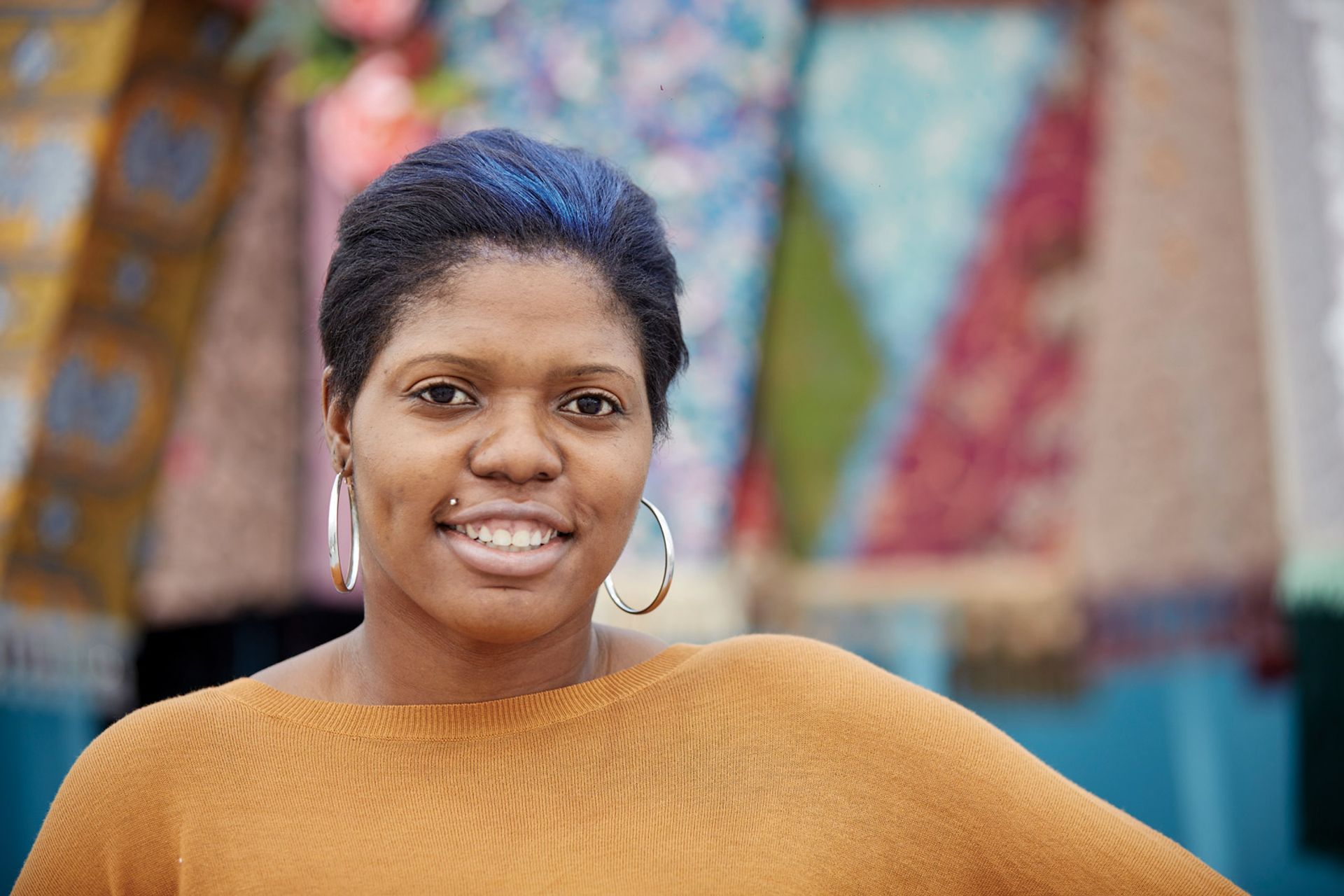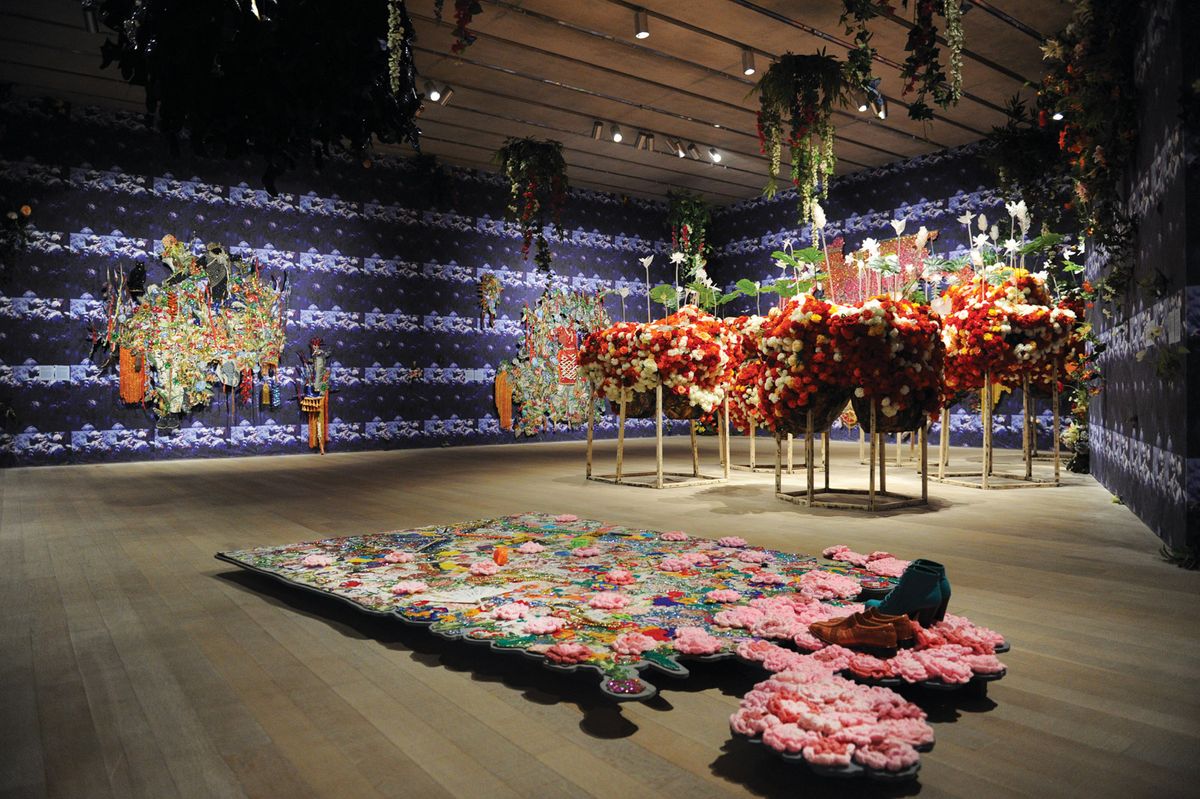The Jamaica-born, US and Jamaica-based artist Ebony G. Patterson describes her immersive exhibition at the Pérez Art Museum Miami (Pamm) as the “most intense” installation process for a work she has done so far. The 37-year-old, who considers herself a painter but works in multiple media, uses materials associated with beauty or wealth, including tapestry, jewellery, glitter, beading and crochet, to explore intersecting themes such as global black youth culture (including Jamaican dancehall), class, race and gender norms and pageantry. Organised by Pamm’s chief curator Tobias Ostrander, the show features six new commissions and seven other works from the past five years, including videos, mixed-media installations, paintings and embellished tapestry pieces. Titled …While the dew is still on the roses…, a reference to a popular hymn describing an encounter with God in a garden, the exhibition explores Patterson’s repeated use of such landscapes, including the garden as an extension of the body. There is a transformation of the works on view into one large “night garden” installation, with twilight-coloured wallpaper, vegetation growing up the walls and silk flora falling from the ceiling. We spoke with Patterson about the “muchness” of her ornate works, the seductive trap of beauty and her relationship with Miami.

Ebony G. Patterson Courtesy of the artist and Monique Meloche Gallery, Chicago
The Art Newspaper: How has your work changed over the years, and what kinds of shifts are you trying to convey through the show?
Ebony Patterson: Pictorially, it has become bigger and more lush. The newer work has taken on a lot of the language of installation. I want the viewer to become trapped within the paintings—physically, psychologically and emotionally. My work has always had this undercurrent of bearing witness… The newer work, because of its scale, places the audience within the centre of everything, [which forces the] visitors to question where they are in relation to the images at which they are looking.
You were speaking about the power dynamics of who bears witness to something and how that works in the installation.
My latest set of works, the Dead Treez series, were inspired by crime scene photographs. I found that often these images, which tend to depict people of colour or individuals from working-class communities, are circulated on social media, so the last set of works examines the dynamics around the way we consume images, especially those that show violence. I was also interested in how photographing [the victims’] loved ones at their most vulnerable moment, [in mourning], was also an act of violence. The new images are primarily built on photographs I’ve collected from newspaper clippings. The works are bodies that are nestled within overgrown [gardenlike] spaces—but they’re gardens that seem to have gone awry. For me, the garden, while beautiful, has become a metaphor for death. It is also a metaphor that relates to post‑colonial societies or spaces. What does it mean for people who live in places with unattended gardens, but at the same time, irrespective of the neglect of these places, to have to find ways to exist and press forward? In these new images, the floral environment almost seems like it’s taking over the bodies. There are clearly moments where bodies or parts—like maybe just a hand [not visibly connected to a body]—seem to be oozing out of all this lushness and prettiness.
I want the viewer to become trapped within the paintings—physically, psychologically and emotionally.
Your works are so lush and ornate. How does beauty relate to the themes in your work?
Oh, it’s a trap. It’s a total trap! One, it’s a trap in the sense that I’m interested in using materials [such as pearls or costume jewellery] that we associate with prettiness, as a way of luring or pulling in the viewer. All the time I get asked, because it’s so much [ornamentation], when do I know that it’s too much? But the muchness of it all—the minute you start to dig beyond its beauty—is when you really begin to see that this is actually not as beautiful as it seems; there is a lot of conflation between the layers of beauty and the layers of violence. The other thing that I’m interested in is just thinking about the garden and the earth as a metaphor—the idea that we come from the earth, we exist on the earth and we return to the earth. While we live, there is this enthralment with beauty or cultivating beauty. I’m interested in the way we use dress, and its relationship to pageantry and beauty, particularly with working-class people— how that becomes an act of gardening, but gardening that’s happening on the body.

Ebony G. Patterson's Dead Tree in a Forest... (2013) Courtesy the artist and Monique Meloche Gallery, Chicago.
How does it feel to stage this exhibition in Miami, which has strong connections to Jamaica and the Caribbean diaspora community? Is this something you considered when you worked on this?
These are not necessarily immediate concerns of mine… But it’s interesting that I started thinking a lot about the ideas around witnessing when I was last in Miami, during a residency in 2013. The imagery I made at the time also started to become much denser and more narrative, which has become a part of the language of my work ever since. It’s also funny that one of the works that I had made during that residency [Dead Tree in the Forest] is in the show as a kind of precursor to this moment. So, I think there are definitely things about Miami visually, and also, too, materially, that I find useful. But even more importantly, I think that being able to work with an institution like the Pérez is just fantastic because it is taking this wild trip with me… I could do a million mock-ups and none of us will know what will happen until we actually get this shit done.
• Ebony Patterson: ...While the dew is still on the roses… Pérez Art Museum Miami, until 5 May 2019


